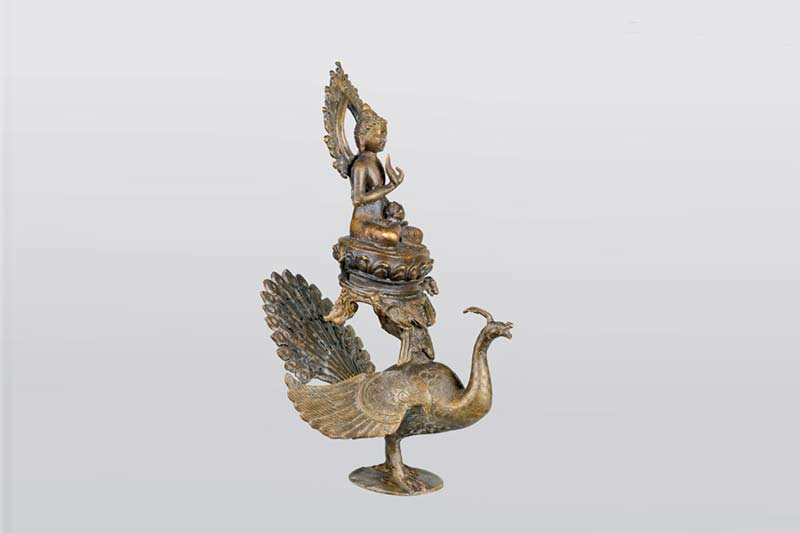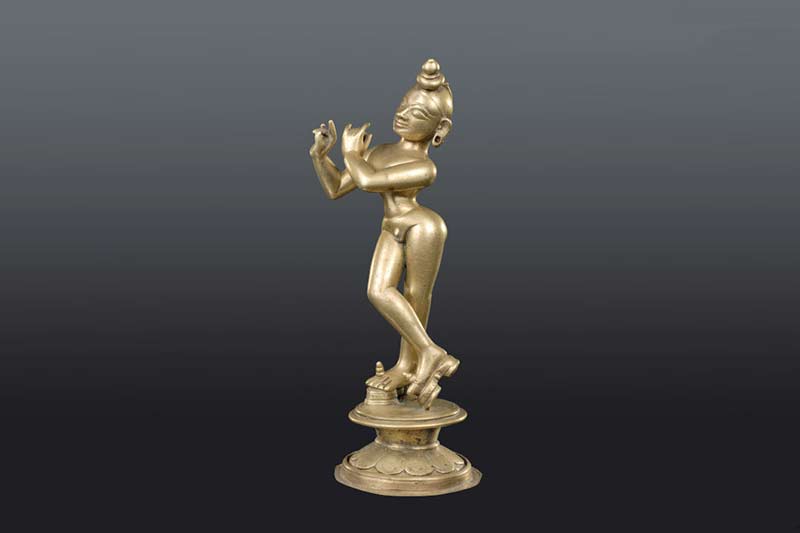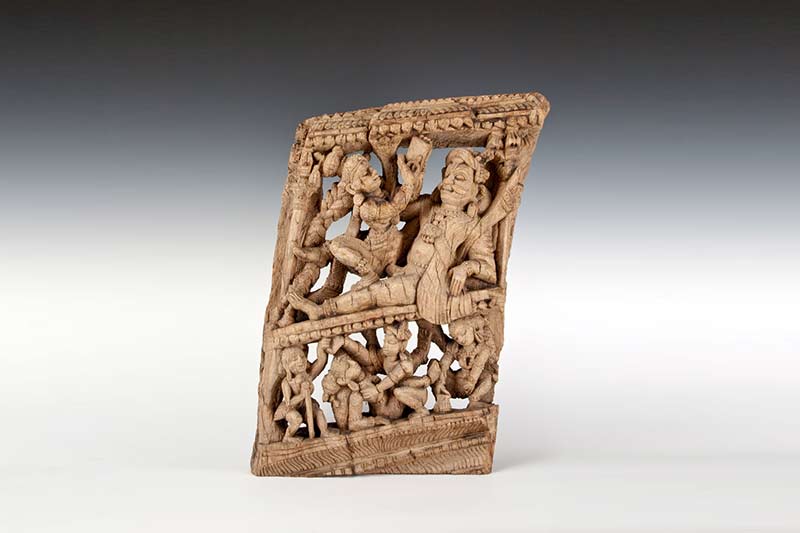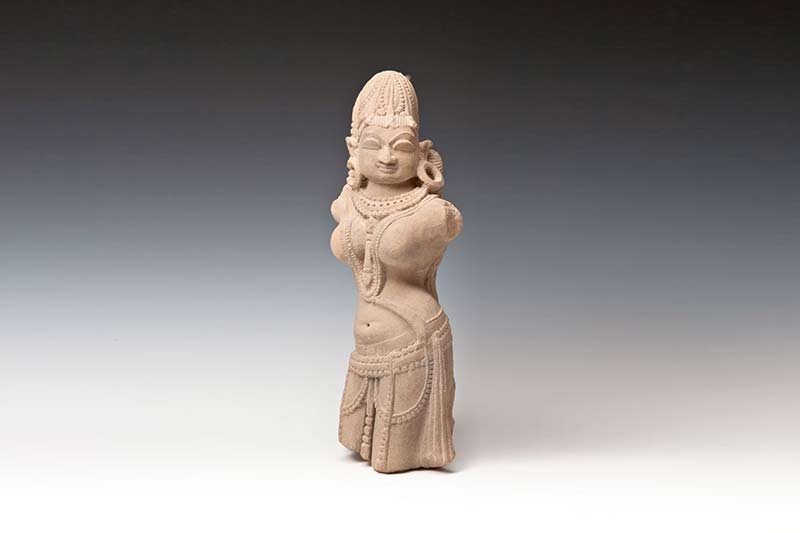The art of India
South East Asian Art Collection
3000-1800 BC
The first signs of human presence in India date back to the prehistoric years. The first systematically organised settlements – also known as “Indus Valley Civilisation” or “Harappa Culture”- appeared along the Indus River Valley from 3000 to 1800 BC.1800-6th cent.BC
Around 1800 BC, Arian nomad tribes came from central Asia, started invading Punjab and settled in the entire Indus Valley. The Arians replaced the Indus Valley civilisation, stratified Indian society into castes or classes and composed the Hindu sacred texts: Vedas and Upanishads.6th-4th cent. BC
In the 6th century BC, Buddha and Jina, the founders of Buddhism and Jainism respectively, were born in India. From the 6th until the 4th century BC, two great western leaders, Darius of Persia in 518 ΒC and Alexander the Great in 327-325 BC, enter India and contribute in the shaping of its civilisation and culture.4th-1st century BC
In 320 BC, the first Indian Empire is founded by the Maurya dynasty with its capital city near modern Patna. Under Emperor Ashoka (272-231 BC), monument art on stone appears for the first time. During the Mauryas, the Greek monarch of Bactria Demetrius invaded the northwest of India and occupied many regions. His work was continued by the general Apollodotus and particularly by Menander (also known to Indians as Milinda) who was converted to Buddhism. It was at that time that Buddhism and Greek sculpture came together and heralded the Gandharan Greco-Buddhist art.1st-3rd century AD
During the 1st-3rd century AD, northern India was ruled by the Kushan, a nomad tribe from the north-western borders with China. The Kushan, carriers of the Central Asian nomadic art, assimilated the Greco-Bactrian cultural heritage and created two entirely different iconographic types of Buddha: the Hellenised Gandhara type and the Indian Mathura type. At the same time, the Indian south was divided into different feudal states.4th-6th century AD
The period between the 4th and the 6th century AD, under the Gupta Empire, is referred to as the “Golden Age” of Indian culture. Literature, mathematics, astronomy and medicine flourished during this era. The Gupta Buddhist sculpture served as a model for artists all over the Buddhist world, while during the same dynasty the Hindu temple took form.7th-12th century AD
From the 7th until the 12th century AD, the “Indian Medieval Times” follow, characterised by the domination of a feudal regime and the creation of many local kingdoms all over the Indian peninsula. These kingdoms on the one hand brought on political instability and on the other developed autonomous art styles, although they maintained Gupta art as the main model. It is a period during which Buddhism declined and Hinduism took over permanently. The Hindu pantheon asserts its prevalence in central India, where impressive temples with erotic sculptures covering their entire exterior were erected. The most well-known are the ones in Khajuraho.12th-16th century AD
The decline of these medieval and mainly the Gurjara-Pratihara dynasty, one of the most significant ones in northern India, paved the way for the Muslims who took over Delhi in 1193 and created the Delhi Sultanate (1193-1526 AD). In the late 14th and during the 15th century, India was invaded several times from the north. Timur (Tamerlane) was also one of the invaders who destabilised the Sultanate’s hegemony and allowed Indian kingdoms to become considerably stronger in the south. In 1498, the Portuguese explorer Vasco da Gama arrived in southern India and in 1510 Goa became the capital of the Portuguese Indian state. This settlement was the precursor of European and especially British colonialism.16th century-1947
In the 16th century starts the hegemony of the Timurid prince Babur. During the Mughal Empire (1526-1858) India saw the flourishing of painting and burial monument architecture, the culmination of which was the Taj Mahal (1631-1643). Mongol domination led a large part of the Indian population to gradually convert to Islam, while Christianity was spread all over the south by Portuguese missionaries. The British East India Company was particularly manifest in India as was the British colonial presence until the mid-20th century. In 1947, the British relinquished ruling power to the first Prime Minister of the Republic of India, Jawaharlal Nehru and his counterpart in Pakistan, Prime Minister Muhammad Ali Jinnah.The Indian peninsula
The Indian peninsula is divided into three geographical areas. The first (northernmost) one includes the Himalayan Range which runs through it from the west to the east. The second (central) one includes the rivers Indus and Ganges and the third (southernmost) one includes the Deccan plateau.
India was home to Hinduism, Buddhism and Jainism, all religious but mainly philosophical systems that promise salvation through specific lifestyles and worldviews. Today, out of an Indian population of 850 million, 820 are Hindus, 8 are Buddhists and 4 are Jains. The rest of the people adhere to other religions such as Islam, Judaism, Christianity and Zoroastrianism. This populous and polytheistic country still maintains the strict social class
order that was created in ancient times. Indians are divided in 4 main castes or classes that attribute their members a predefined and invariable social role.
Hinduism
Hinduism is the dominant religion of India, practised by 85% of the country’s population. The long history of Hinduism, that dates back to 500 BC-1000 AD, was the cause for the fact that when one refers to this religion today, one does not imply a single faith system but an ensemble of different Indian creeds and traditions that accept the sacred Vedas and Upanishads. The western term “Hinduism” is the Sanskrit equivalent of “Darshana”
which means “viewing” or “looking at”. The ultimate goal is the “Atman” (that describes the soul) which reincarnates from one body to the next until it attains “Moksha” or salvation, allowing it to escape the endless cycle of reincarnations to which it is intricately bound by the “Karma”. The “Karma” is the sum of one’s actions and the force that determines one’s next reincarnation.
In the populous Hindu pantheon
In the populous Hindu pantheon, which includes approximately 33 million deities, Vishnu, the preserver of the world, is the most significant. He is combined with two other deities, Brahma, the creator, and Shiva, the destroyer. All three are collectively known as a tripartite deity, Trimurti. Vishnu is the supreme ruler of the universe. He is holding a spinning disc like weapon (chakra) and a conch shell (shankhya). His sacred animal is the mythical being Garuda and his consort is the goddess of Fortune, Lakshmi. His omnipresence is achieved through his multiple incarnations (avatars), the most well-known of which being Rama, hero of the Ramayana epic, and Krishna, hero of the Bhagavad Gita sacred poem. Krishna is the most significant incarnation of the god Vishnu and is worshipped by many Hindus. The enticing sound of his flute –which resembles his voice- makes people forget their daily duties and beckons them close. Shiva, his mission being destruction and creation anew, expresses at the same time the destructive and the creative power of the Supreme Being. He has three eyes and holds a trident. His sacred animal is Nandi, the bull and his consort the goddess Parvathi. His presence is often signified by the
Shiva Linga phallic symbol of fertility, while his dance as Shiva Nataraja symbolises the world’s perpetual motion.
Eroticism
Eroticism constitutes a fundamental concept of Indian culture. It is eloquently portrayed in writings, erotic complexes that surround Hindu temples as well as in fretworks adorning the interior of temples or god chariots (rathas) in processions. The depiction of a “Mithuna” (a couple in an erotic embrace), is considered as symbolising the transcendence of the male-female distinction and the re-embodiment in the primeval-Absolute. However, sexual positions have a complex meaning that has not yet been elucidated.
Jainism
Jainism is a remarkable religious-philosophical teaching. It originated from “Mahavira”, the Great Hero, a title attributed to Vardhamana Gnatputra who lived in the 6th century BC and, according to tradition, succeeded 23 prophets, the Tirthankaras or Jinas.
According to Jainism, there are two forms of entities in the world: Jiva (souls or living things) and Ajiva (matter or non-living things). The aim of every soul is to free itself from matter without losing its unique identity and self-consciousness. This aim can only be attained through strict asceticism and meditation. Today, Jainism followers are approximately 3,500,000. Of interest are the small bronze cast worship shrines, in which the Jina in the centre is surrounded by his symbols.
Buddhism
Buddhism is not just a religion: it is mainly a philosophy and a lifestyle. It was founded by the Indian Prince Siddhartha Gautama who lived in the 6th century BC. After wandering about in order to find a solution to the evils of human existence, he experienced the Great Enlightenment which consists of realising that reality is an illusion and transcending one’s selfish existence, thus becoming the Buddha or “The Awakened One” or “The Enlightened One”. Consequently, the name “Buddha” does not refer only to this specific historical figure, but to any being that attains spiritual awakening and divine enlightenment.
The core concept of Buddhist teaching is salvation from human suffering and the reincarnation cycle taught by Hinduism. Fundamental parameters are the faith in reincarnation, renouncement of all that is of worldly interest, as well as love, compassion and respect for all living beings. Today there are but 8 million followers were Buddhism was born.
Buddha on a peacock

Krishna

Hindu fretwork of a erotic content from o processional chariot

Goddess from a
Hindu temple exterior


